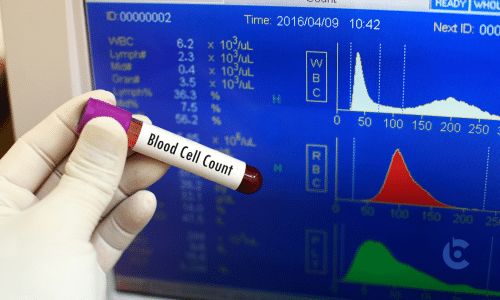Blood cell counting, also known as complete blood count (CBC), is a fundamental laboratory test used to diagnose and monitor various health conditions. It provides vital information about the number, size, and maturity of different blood cell types. As a medical lab technician, performing accurate and reliable blood cells counting methods is a crucial skill in your arsenal.
This comprehensive guide delves into the blood cell counting methods, equipping you with the knowledge and best practices to ensure accurate results.
Understanding Blood Cell Counting
Blood cell counting is a laboratory test done by medical lab technician used to measure the number and types of blood cells present in a sample. It provides valuable information about a patient’s overall health and can help diagnose conditions such as anemia, infections, and blood disorders.
What are the Different Types of Blood Cells?
There are 3 main types of blood cells: red blood cells (RBCs), white blood cells (WBCs), and platelets. Each type plays a unique role in the body’s immune system and oxygen transport.
Common Blood Cell Counting Methods for Medical lab technician
1. Manual Cell Counting
Manual cell counting involves visually examining a blood sample under a microscope and manually counting the number of cells present. This method requires careful attention to detail and is typically used for low-volume samples or when automated methods are unavailable.
2. Automated Cell Counting
Automated cell counting utilizes specialized equipment, such as hematology analyzers, to quickly and accurately count blood cells. These instruments use a combination of optical and electronic methods to analyze the sample and provide precise cell counts.
Advanced Blood Cell Counting Methods
1. Differential Cell Count
Differential cell counting involves identifying and quantifying the different types of white blood cells present in a blood sample. This information can provide valuable insights into the body’s immune response and help diagnose specific medical conditions.
2. Flow Cytometry
Flow cytometry is a sophisticated technique that uses lasers and fluorescent markers to analyze individual cells based on their size, shape, and surface markers. It is commonly used for research and specialized diagnostic purposes.
Tips for Accurate Blood Cell Counting Methods
1. Proper Sample Preparation: The Foundation for Reliable Results
Accurate blood cell counting relies heavily on a well-prepared blood sample. Here’s why proper sample preparation is crucial:
Preventing Clot Formation: Blood naturally begins to clot after leaving the body. If clots are present in the sample, they can interfere with the analyzer’s ability to accurately count and differentiate cells. Blood cell counting methods like gentle mixing of the blood sample with an anticoagulant and following recommended turnaround times for analysis are essential.
Avoiding Hemolysis: Hemolysis refers to the breaking of red blood cells. Hemolyzed samples release hemoglobin, a protein within red blood cells, into the plasma. This can turn results by artificially elevating hemoglobin levels and potentially affecting other parameters. Careful handling of the blood sample during collection and transport minimizes the risk of hemolysis.
Here are some additional points to consider for optimal sample preparation:
Mixing Techniques: Gently inverting the blood collection tube several times ensures homogenous distribution of cells throughout the sample. Avoid vigorous shaking, as this can damage fragile white blood cells.
Fill Volume: Ensure the blood collection tube is filled to the appropriate level as indicated by the manufacturer. Underfilling can lead to inaccurate results due to improper dilution ratios.
Temperature Control: Maintain blood samples at room temperature ranges between 15° and 30°C or as recommended by the manufacturer’s guidelines. Extreme temperatures can affect cell morphology (shape) and potentially impact the analysis.
2. Calibration and Quality Control: Ensuring Accuracy Every Time
Calibration and quality control as your internal checks and balances in the world of blood cell counting. These practices ensure that your equipment is functioning optimally and delivering reliable results.
Calibration: Automated hematology analyzers require periodic calibration to maintain their accuracy. This process involves using standardized control materials with known cell counts to verify the instrument’s performance. Calibration frequency is typically dictated by the manufacturer’s recommendations and might also be influenced by factors like workload and instrument usage patterns.
Quality Control: Regular quality control checks are vital to monitor the day-to-day performance of the analyzer. This involves running control samples with known cell counts throughout the testing process. Comparing the obtained results with the expected values allows you to identify any deviations that might require corrective actions like recalibration or instrument troubleshooting.
3. Dilution Techniques: Maintaining the Counting Sweet Spot
Automated blood cell analyzers have a defined linear range within which they can accurately count cells. If the cell concentration in the blood sample falls outside this range (too high or too low), the counts might be inaccurate. This is where dilution techniques come into play.
High Cell Counts: If the blood sample has a very high number of cells (e.g., in patients with certain blood disorders), it might need to be diluted with a specific diluent solution. This dilution helps ensure that the analyzer can accurately count the cells within the defined counting grid or chamber.
Low Cell Counts: Conversely, blood samples with very low cell counts (e.g., in patients with severe bone marrow suppression) might require concentration techniques before analysis. These techniques are less commonly used in routine blood cell counting but are crucial for ensuring accuracy in specific clinical scenarios.
Final Thought!
Mastering blood cell counting methods is essential for medical lab technician to provide accurate diagnoses and monitor patient health effectively. By understanding the principles and techniques outlined in this guide, technicians can ensure reliable results and contribute to better patient outcomes.
If you’re in a field of healthcare and looking to enhance your skills in blood cell counting, We at BizTech College offers comprehensive medical lab technician training program tailored to your needs.
Register today to learn more and take your career to the next level!

